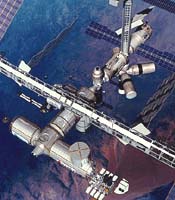| . |  |
. |
 Zero-G Could Seriously Impact Living Cells
Zero-G Could Seriously Impact Living Cellsby Debora MacKenzie Brussels - July 15, 2000 - The skeletons within living cells may not form properly in zero gravity, say researchers in France. This could dent human ambitions to live in space -- at least without artificial gravity. Their work also proves that, contrary to received wisdom, gravity can influence chemical reactions. Most cells have cytoskeletons of microtubules, which are fibres made of the protein tubulin. James Tabony and his colleagues at the French Atomic Energy Commission lab in Grenoble found that when cold solutions of mammalian tubulin and the energy-releasing compound GTP are warmed to body temperature for six minutes, microtubules form in distinct bands. What is striking is that the bands form at right angles to gravity or, if spun, to the centrifugal force. To prove gravity is responsible, the team sent up tubulin on a European Space Agency (ESA) rocket, which exposed its payload to 13 minutes of weightlessness. Some tubulin experienced only microgravity while being warmed for the critical six minutes, but other samples were spun in a centrifuge. The spinning microtubules formed bands as usual, but those that experienced only microgravity pointed in all directions. "This shows gravity triggers the pattern," says Tabony. "Physicists insisted this research wasn't worth doing, because gravity is too small, compared to electrostatic or thermal forces on molecules, to affect chemical reactions," says Didier Schmitt, head of life sciences at ESA's European Space Technology and Research Centre in Noordwijk, the Netherlands. "This proves they were wrong." Work by Marian Lewis of the University of Alabama at Huntsville suggests that gravity may also help orient microtubules inside living cells. She has flown human white blood cells on board the space shuttle. "Normally, the microtubules form long, straight fibres radiating towards the cell membrane," Lewis says. But after a day in orbit, the microtubules were going in random directions, she says. However, it is not yet clear whether microgravity or the vibrations during takeoff are to blame. The findings might explain some of the health problems people living in space have, such as depressed immune systems. "Over a long time, or for generations," says Tabony, "I suspect we wouldn't do well at all." Tabony says the formation of the microtubule bands is also the first experimental model of biological self-organisation, in which chemical reactions spontaneously generate patterns in response to tiny asymmetries in the environment. This was predicted by Alan Turing in the early 1950s, and later by biophysicist Ilya Prigogine, a Nobel prizewinner.
This article appeared in the July 15 issue of New Scientist New Scientist. Copyright 2000 - All rights reserved. The material on this page is provided by New Scientist and may not be published, broadcast, rewritten or redistributed without written authorization from New Scientist.
SPACE MEDICINE
|
| |||||||||
| The content herein, unless otherwise known to be public domain, are Copyright 1995-2016 - Space Media Network. All websites are published in Australia and are solely subject to Australian law and governed by Fair Use principals for news reporting and research purposes. AFP, UPI and IANS news wire stories are copyright Agence France-Presse, United Press International and Indo-Asia News Service. ESA news reports are copyright European Space Agency. All NASA sourced material is public domain. Additional copyrights may apply in whole or part to other bona fide parties. Advertising does not imply endorsement, agreement or approval of any opinions, statements or information provided by Space Media Network on any Web page published or hosted by Space Media Network. Privacy Statement All images and articles appearing on Space Media Network have been edited or digitally altered in some way. Any requests to remove copyright material will be acted upon in a timely and appropriate manner. Any attempt to extort money from Space Media Network will be ignored and reported to Australian Law Enforcement Agencies as a potential case of financial fraud involving the use of a telephonic carriage device or postal service. |